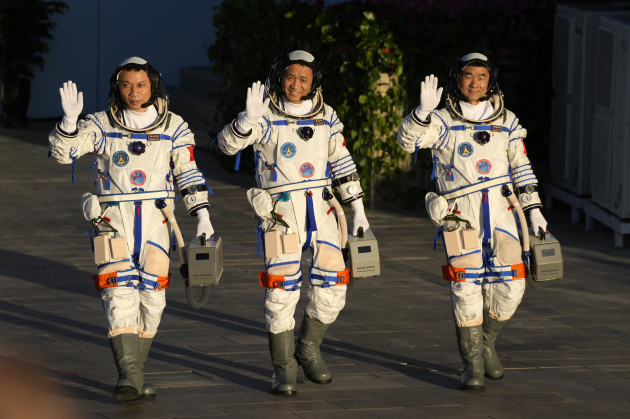Updated 1 hour ago
Source: TheJournal.ie/Youtube
A Chinese spacecraft carrying a three-man crew has docked at China’s new space station at the start of a three-month mission, marking a milestone in the country’s ambitious space program.
The Shenzhou-12 spacecraft was connected to a module of the Tianhe Space Station about six hours after liftoff from the Jiuquan launch center on the edge of the Gobi Desert.
The three astronauts are the first to gain accommodation in the main living unit and will conduct experiments, test equipment, perform maintenance, and prepare the station to receive two lab units next year.
The mission brings the number of astronauts China has launched into space since 2003 to 14, becoming only the third country after the former Soviet Union and the United States to do so alone.
The astronauts were seen by space officials and other military in uniform, and a crowd of children waved flowers and flags and sang patriotic songs.
The missile dropped its boosters about two minutes into the flight, followed by the funnel surrounding the Shenzhou-12 at the top of the missile. After about 10 minutes, it detached from the top of the rocket and extended its solar panels and shortly thereafter entered orbit.
About a half-dozen adjustments were made over the six hours following the spaceship’s row to dock with the Tianhe Module, or Heavenly Harmony, at about 4pm (8am Irish time).
The mission’s deputy chief designer, Gao Shuo, told state broadcaster CCTV that the travel time was reduced from the two days it took to reach the previous experimental space stations in China, as a result of «many breakthroughs and great innovations.»
«So astronauts can rest well in space which makes them less tired,» Zhao said.
Source: AP / PA Images
Chinese astronauts, from left, wave Tang Hongbo, Ni Haisheng, and Liu Beoming as they prepare to board the plane.
Source: Ng Han Guan / PA
Other improvements include an increase in the number of automated and remote-controlled systems that should «significantly reduce the pressure on astronauts,» Zhao said.
No news is bad news
magazine support
is yours contributions You’ll help us keep delivering the stories that matter to you
Support us now
Two of the astronauts on those previous missions were women, and while the first station crew was all male, women are expected to be part of future station crews.
The mission is the third of 11 planned over the next year to add additional sections to the station and send in crews and supplies. A new crew of three and a cargo ship with supplies will be dispatched within three months.
China does not participate in the International Space Station, due in large part to US objections to the secrecy of the Chinese program and close military ties. However, China has strengthened its cooperation with Russia and a host of other countries, and its station may continue to operate outside the International Space Station, which is nearing the end of its functional life.
China landed a probe on Mars last month carrying a rover, Zurong, and earlier landed a probe and rover on the far side of the less explored moon and returned the first lunar samples by any nation’s space program since the 1970s.
This week China and Russia also unveiled an ambitious plan for a joint international lunar research station extending into 2036. That could rival and possibly conflict with the multinational Artemis Agreements, a blueprint for space cooperation that supports NASA’s plans to return humans to the Moon by 2024 and launch a historic human mission to Mars.
After the Tianhe launch in April, the rocket that carried it into space made the uncontrolled re-entry to Earth, although China dismissed criticism of the potential safety risk. Discarded rocket stages typically enter the atmosphere shortly after takeoff, usually over water, and do not enter orbit.
The rocket in use today is of a different type, and the components that will re-enter are expected to burn long before they become dangerous, said Ji Qiming, assistant director of the China Manned Space Agency.

«Lector profesional. Jugador galardonado. Aficionado a los zombis. Adicto a las redes sociales. Experto en tocino. Erudito en Internet»
